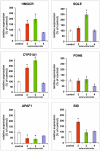New Steroidal Selenides as Proapoptotic Factors
- PMID: 38005248
- PMCID: PMC10673341
- DOI: 10.3390/molecules28227528
New Steroidal Selenides as Proapoptotic Factors
Abstract
Cytostatic and pro-apoptotic effects of selenium steroid derivatives against HeLa cells were determined. The highest cytostatic activity was shown by derivative 4 (GI50 25.0 µM, almost complete growth inhibition after three days of culture, and over 97% of apoptotic and dead cells at 200 µM). The results of our study (cell number measurements, apoptosis profile, relative expression of apoptosis-related APAF1, BID, and mevalonate pathway-involved HMGCR, SQLE, CYP51A1, and PDHB genes, and computational chemistry data) support the hypothesis that tested selenosteroids induce the extrinsic pathway of apoptosis by affecting the cell membrane as cholesterol antimetabolites. An additional mechanism of action is possible through a direct action of derivative 4 to inhibit PDHB expression in a way similar to steroid hormones.
Keywords: HeLa cells; antimetabolites; cell growth inhibition; gene expression; in vitro culture.
Conflict of interest statement
The authors declare no conflict of interest.
Figures













Similar articles
-
Biotinylated selenocyanates: Potent and selective cytostatic agents.Bioorg Chem. 2023 Apr;133:106410. doi: 10.1016/j.bioorg.2023.106410. Epub 2023 Feb 8. Bioorg Chem. 2023. PMID: 36822000
-
Cytostatic and antiviral activity evaluations of hydroxamic derivatives of some non-steroidal anti-inflammatory drugs.Chem Biol Drug Des. 2009 Mar;73(3):328-38. doi: 10.1111/j.1747-0285.2009.00774.x. Chem Biol Drug Des. 2009. PMID: 19207469
-
The carcinostatic and proapoptotic potential of 4-hydroxynonenal in HeLa cells is associated with its conjugation to cellular proteins.Anticancer Res. 2001 May-Jun;21(3B):1997-2004. Anticancer Res. 2001. PMID: 11497289
-
Regulation of p21 expression for anti-apoptotic activity of DDX3 against sanguinarine-induced cell death on intrinsic pathway.Phytomedicine. 2019 Dec;65:153096. doi: 10.1016/j.phymed.2019.153096. Epub 2019 Sep 23. Phytomedicine. 2019. PMID: 31568920
-
New insights into cellular cholesterol acquisition: promoter analysis of human HMGCR and SQLE, two key control enzymes in cholesterol synthesis.Biochim Biophys Acta Mol Cell Biol Lipids. 2017 Jul;1862(7):647-657. doi: 10.1016/j.bbalip.2017.03.009. Epub 2017 Mar 23. Biochim Biophys Acta Mol Cell Biol Lipids. 2017. PMID: 28342963
References
-
- Romero-Hernández L.L., Merino-Montiel P., Montiel-Smith S., Meza-Reyes S., Vega-Báez J.L., Abasolo I., Schwartz S., López Ó., Fernández-Bolaños J.G. Diosgenin-based thio(seleno)ureas and triazolyl glycoconjugates as hybrid drugs. Antioxidant and antiproliferative profile. Eur. J. Med. Chem. 2015;99:67–81. doi: 10.1016/j.ejmech.2015.05.018. - DOI - PubMed
-
- Huang Y., Peng Z., Wei M., Pang L., Cheng Y., Xiao J.-A., Gan C., Cui J. Straightforward synthesis of steroidal selenocyanates through oxidative umpolung selenocyanation of steroids and their antitumor activity. J. Steroid Biochem. Mol. Biol. 2023;225:106203. doi: 10.1016/j.jsbmb.2022.106203. - DOI - PubMed
MeSH terms
Substances
LinkOut - more resources
Full Text Sources

